|
This section contains 5,555 words (approx. 19 pages at 300 words per page) |

|
SOURCE: "'Stanley Fish Was My Reader': Cleanth Brooks, the New Criticism, and Reader-Response Theory," in The New Criticism and Contemporary Literary Theory, edited by William J. Spurlin and Michael Fisher, Garland Publishing, New York City, 1995, pp. 211-26.
Below, Beck and Rhoades compare Brooks's New Criticism and Stanley Fish's Reader-Response theory.
The method of literary analysis which became known as the New Criticism began in meetings of the Nashville Fugitives during the 1920s, when John Crowe Ransom dominated the group. Between 1921 and 1925–1926, Ransom's students included Robert Penn Warren and Cleanth Brooks, who were to codify the "method" for use, first in their classes at LSU, and then in their critical essays and textbooks. Brooks, never a Fugitive and connected only briefly with Agrarianism, began to work out his own approaches to reading. He credits not only Ransom but also I. A. Richards and T. S. Eliot with having influenced...
|
This section contains 5,555 words (approx. 19 pages at 300 words per page) |

|


